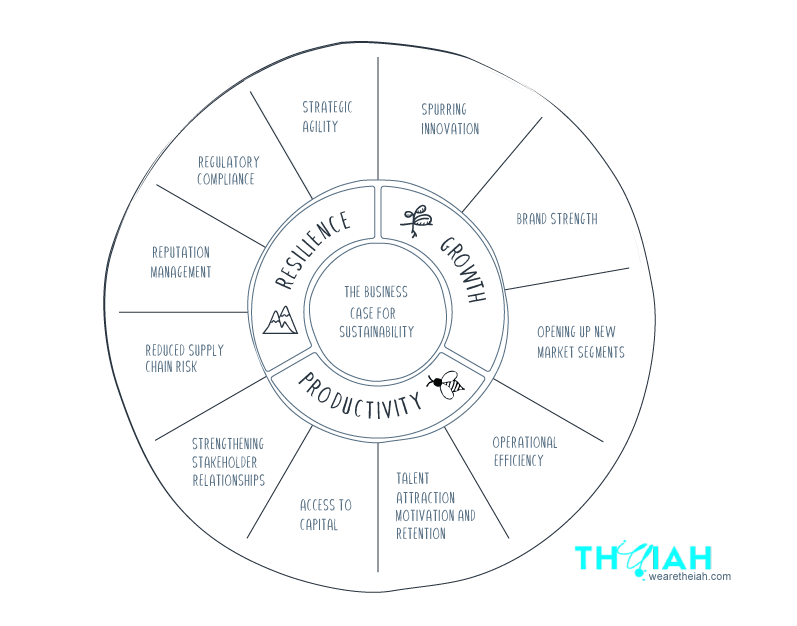Theiah insights

Growth > New Markets
Building sustainability into your business can give your company access to new consumer and product markets; and can grow the whole market to boot.
“Many CEO’s see their job as taking the largest slice of a fixed pie. A radically different approach is to think of growing the pie. That’s what happens when you focus on creating value for society.”
Alex Edelmans, London Business School Professor of Finance; Academic Director, Centre for Corporate Governance (CCG)
New consumer markets
- A new consumer archetype is emerging: A clearly defined, lucrative group of consumers put sustainability first in decision making, and this is increasing year-on-year: estimated to be 37% of the market in 2019 (1)
- There is an enormous 26.8% growth rate in the market for sustainable and ethical products (5-year CAGR). (2)
- In one survey from Accenture, 72% of respondents reported that they were actively buying more environmentally friendly products than they did five years ago, while 81% said they expected to buy even more over the next five years. (3)
- Unmet needs and under-served markets: 88% of consumers want brands to help them live sustainably, BUT nearly half of consumers feel brands make it harder for them to live sustainably. The best products solve a pressing need, and there is one right here. (4)
- A new generation: As Generation Z (1996-2015) comes of purchasing-age, they will be the largest consumer segment: 73% of them are willing to pay more for sustainability, (5) and nearly half will abandon a purchase if it doesn’t match their values (6).
- Targeting emerging markets: The lucrative emerging middle class has especially high expectations: consumers in emerging economies are more engaged in sustainability and expect companies’ good purpose efforts to benefit them directly. (7)
- Alcoa, a US Aluminium, company found the company’s superior environmental performance track record has enabled it to position itself positively relative to its competitors and gain access to attractive growth projects in new markets like Brazil. (8)
New technology and product markets
New product innovations can create completely new markets. Cleantech is one example, presenting an enormous opportunity. This includes innovations in clean energy, technology, chemical, and engineering aimed at reducing or tracking environmental impact.
- The global clean technology market is worth more than £1.6 trillion a year and is on track to double in size by mid-2025. (9)
- The market has grown at an average of almost 12% a year since 2007, and predicts it will continue to accelerate over the coming years. (9)
- Germany, Denmark, and Quebec in Canada (where Theaih is based!) are leaders in the cleantech sector and are carving out a remarkable first moved advantage, having jumped on the trend early.
- Biodesign is also an emerging field, creating new products from waste. One Canadian study found there was an CA$150-240b market in repurposing waste cross industries. (15)
- New materials: Sustainability drives product innovation at IKEA - their line of sustainable products like LED bulbs and solar panels from its Products for a More Sustainable Life at Home now generate a billion dollars. (13)
New business models
- Financial models: Lemonade is a socially-conscious insurance company: they only takes a flat fee on every insurance. Any of the surpluses not claimed goes to the charity of the customer’s choice. Good for society - and business: consumers don’t feel the need to trick their insurance as they would give away less money to the charity of their choice. (10)
- From products to services: Models such as circular design have incentivised some companies to transition from product to service-based business models. IKEA, in a much-publicised move, they have also recently opened up a second-hand and refurbishment scheme. (11)
And Grief, previously a shipping and logistics company, transitioned to container refurbishment, and eventually to become an industrial packaging company, after an extensive review of both customer preferences and profits available. (12)
References:
6)https://www.drapersonline.com/news/gen-z-shoppers-report-abandoning-unsustainable-purchases
- About
- Journal
- Contact
- # Keep in touch
- support@aristotheme.com
- +90 530 737 2 444
- # Socials
- dribble
- youtube
- About
- Journal
- Contact
- External Link
- # Keep in touch
- support@aristotheme.com
- +90 530 737 2 444